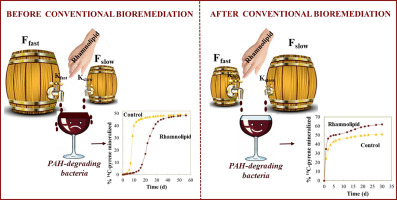Science of the Total Environment ( IF 9.8 ) Pub Date : 2019-03-06 , DOI: 10.1016/j.scitotenv.2019.03.056 Rosa Posada-Baquero , Magdalena Grifoll , José-Julio Ortega-Calvo

|
The application of a rhamnolipid biosurfactant for enhanced solubilization and biodegradation of slowly desorbing polycyclic aromatic hydrocarbons (PAHs) in contaminated soils was determined in this study. The soil samples exhibited different levels of pollution and different bioremediation stages: the first soil originated from a creosote-polluted site, contained 4370 mg kg −1 of PAHs and had not been bioremediated; the second soil was the same as the first but had received bioremediation treatment with nutrient amendment in biopiles for a period of 5 months and contained 580 mg kg −1 of PAHs after this treatment; the third soil was treated by bioremediation for several years to reduce the concentration of PAHs to 275 mg kg −1. The kinetics of PAH desorption were determined to assess the magnitude of the slowly desorbing fractions present in the polluted soil and to optimize the biosurfactant effectiveness in terms of biodegradation. The soils that had been treated by bioremediation were enriched in slowly desorbing PAHs. The rhamnolipid at a concentration above its critical micelle concentration enhanced biodegradation in the soils that had been bioremediated previously. The measurement of residual concentrations of native PAHs showed the promoting effect of the biosurfactant on the biodegradation of the slowly desorbing fractions. Interestingly, benzo(a)pyrene was biodegraded in the soil that had been bioremediated for a long time. Rhamnolipid can constitute a valid alternative to chemical surfactants in promoting the biodegradation of slow-desorption PAHs, which is one of the most important problems in bioremediation, but the efficiency depends strongly on the bioremediation stage in which the biosurfactant is applied.
中文翻译:

常规生物修复后鼠李糖脂增强了土壤中PAHs的增溶和生物降解
在这项研究中确定了鼠李糖脂生物表面活性剂在污染土壤中缓慢溶解的多环芳烃(PAHs)的增溶和生物降解中的应用。土壤样品表现出不同程度的污染和不同的生物修复阶段:第一批土壤是由杂酚油污染的地点产生的,含有4370 mg kg -1的PAHs,尚未经过生物修复。第二种土壤与第一种土壤相同,但已在生物堆中进行了营养改良剂生物修复处理,为期5个月,处理后含有580 mg kg -1的PAHs;对第三种土壤进行生物修复处理数年,以将PAHs的浓度降低至275 mg kg -1。测定PAH解吸的动力学,以评估污染土壤中存在的缓慢解吸级分的大小,并就生物降解而言优化生物表面活性剂的有效性。经过生物修复处理的土壤富含缓慢解吸的多环芳烃。鼠李糖脂的浓度高于其临界胶束浓度,可增强先前已被生物修复的土壤中的生物降解。天然PAHs残留浓度的测量表明生物表面活性剂对缓慢解吸组分的生物降解有促进作用。有趣的是,苯并(a)re在经过长时间生物修复的土壤中被生物降解。鼠李糖脂可以构成化学表面活性剂的有效替代品,以促进缓慢解吸的PAHs的生物降解,

































 京公网安备 11010802027423号
京公网安备 11010802027423号